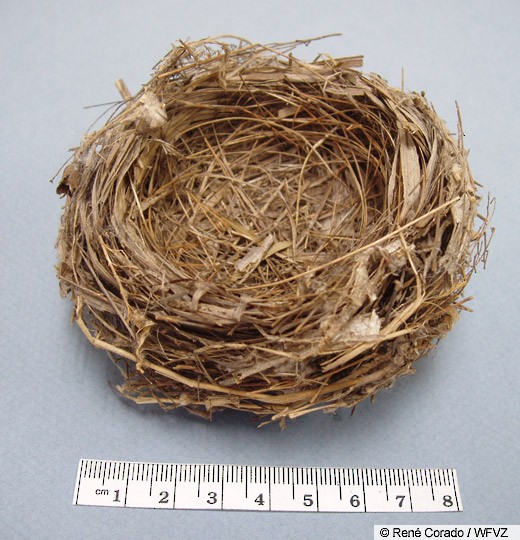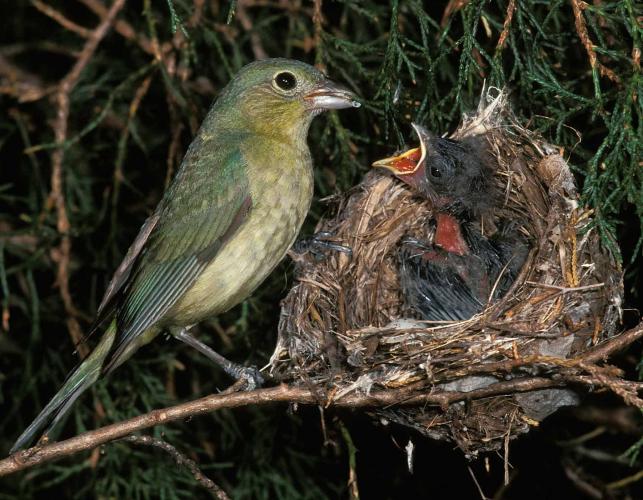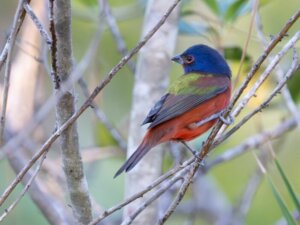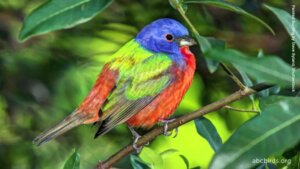Where Do Painted Buntings Nest? Discover Their Secret Hideouts
Painted Buntings are colorful, small birds that capture the hearts of many. But where do they nest?
Painted Buntings typically nest in dense, shrubby areas close to the ground. These birds are known for their vibrant feathers, making them easy to spot. But finding their nests can be a bit of a challenge. They prefer thick, brushy habitats like coastal scrubs, overgrown fields, and forest edges.
This helps them hide from predators. Understanding their nesting habits can help bird watchers and nature lovers get a closer look. In this blog post, we will explore their preferred nesting sites, what their nests look like, and how these beautiful birds care for their young. Get ready to learn more about the secret life of Painted Buntings!
Introduction To Painted Buntings
Painted Buntings are a sight to behold. These birds are known for their vibrant colors and distinctive appearance. They are often described as flying rainbows due to their striking plumage.
In this section, we will delve into the Colorful Characteristics and Geographical Range of these fascinating birds. Understanding these aspects will give you a better idea of where Painted Buntings nest.
Colorful Characteristics
Male Painted Buntings are extremely colorful. They have bright blue heads, green backs, and red underparts. Females, on the other hand, are more subdued with green and yellow hues. This sexual dimorphism makes it easy to distinguish between the sexes.
Here is a quick table summarizing the key color characteristics:
| Gender | Color Characteristics |
|---|---|
| Male | Bright blue head, green back, red underparts |
| Female | Green and yellow hues |
Geographical Range
Painted Buntings are primarily found in the southeastern United States. They are commonly seen in states like Florida, Georgia, and Texas. During the breeding season, they migrate to the northern parts of their range.
Here is an unordered list of states where Painted Buntings are commonly found:
- Florida
- Georgia
- Texas
Understanding their geographical range helps bird watchers locate these stunning birds. Painted Buntings also migrate to Central America during winter. This migration pattern is crucial for their survival.
Preferred Habitat
Painted Buntings are vibrant, colorful birds admired by many birdwatchers. These birds have specific habitat preferences for nesting. Understanding their preferred habitat can help enthusiasts spot them more easily.
Ideal Climate
Painted Buntings thrive in warm climates. They prefer areas with mild winters. These birds migrate to avoid cold weather. During summer, they nest in the southern United States. Florida, Texas, and Georgia are common nesting places. In winter, they travel to Central America.
Vegetation Types
Painted Buntings favor dense, shrubby areas. They nest in thickets and brushy fields. Low trees and shrubs provide shelter and food. These birds also like edges of woodlands. They avoid open, barren areas. The vegetation offers protection from predators. It also provides abundant insects and seeds for feeding.
Nesting Sites
Painted Buntings are small, colorful birds that capture the attention of many bird enthusiasts. Understanding where they nest can help bird watchers spot these beautiful creatures in their natural habitats. Let’s explore the common nesting sites and height preferences of Painted Buntings.
Common Locations
Painted Buntings typically nest in dense shrubs and thickets. They prefer areas with ample cover to hide their nests from predators. In the southeastern United States, they often choose coastal areas and forest edges. These birds also nest in gardens and parks with dense vegetation.
In some regions, Painted Buntings select areas with tall grasses. This provides them with additional protection and camouflage. They also use low trees and bushes in these regions. These birds prefer locations that offer a mix of sunlight and shade.
Height Preferences
Painted Buntings usually build their nests close to the ground. Most nests are found between three and six feet high. This height helps them avoid many aerial predators. It also allows easy access to food sources on the ground.
In some cases, nests may be higher or lower. Nest height can vary depending on the available vegetation. Painted Buntings adapt their nesting habits to their surroundings. This adaptability helps them thrive in different habitats.
By understanding their nesting sites, bird watchers can better locate these beautiful birds. Observing Painted Buntings in their natural habitat is a rewarding experience. Happy bird watching!

Credit: www.youtube.com
Building The Nest
Painted Buntings are small, colorful birds. Their nests are essential for raising young. These nests are well-hidden and carefully built. Each nest is a safe place for eggs and chicks.
Materials Used
Painted Buntings use various materials to build their nests. They collect grass, leaves, and twigs. They also use small roots and pieces of bark. Sometimes, they add soft materials like animal fur.
Construction Process
The female Painted Bunting builds the nest. She chooses a low branch or shrub. This spot is hidden from predators. She weaves the materials together carefully. The nest takes about three days to complete. The inside is soft and cozy for the eggs.
Nesting Season
The Painted Bunting is a colorful songbird. It is famous for its vibrant plumage. But where does this beautiful bird nest? Understanding their nesting habits can be fascinating. Let’s dive into the nesting season of Painted Buntings.
Timing And Duration
Painted Buntings begin their nesting season in late spring. This usually starts around May. The season lasts through the summer, ending in late August. During this period, they raise one or two broods.
Each brood requires a few weeks to mature. The first set of eggs hatches in early June. The second set hatches around mid-July. This ensures their young have enough time to grow before fall.
Breeding Behaviors
Male Painted Buntings arrive first at the breeding grounds. They establish territories and sing to attract females. Their bright colors and songs play a big role in courtship.
Females then choose a nesting site within the male’s territory. They build the nest in dense foliage. This helps protect the nest from predators. The nest is often low to the ground, in shrubs or trees.
Females lay three to four eggs per clutch. Incubation lasts about 12 days. After hatching, both parents feed the chicks. The chicks fledge in about two weeks. They leave the nest but stay close to their parents.
Understanding the nesting season of Painted Buntings can enhance birdwatching experiences. It provides insights into their life cycle and behaviors.

Credit: www.perkypet.com
Conservation Efforts
The conservation of Painted Buntings is essential. These colorful birds face threats due to habitat loss and other factors. Various efforts aim to protect their nesting sites and ensure their survival. Below, we will explore some key conservation strategies.
Habitat Protection
Protecting habitats is vital for the survival of Painted Buntings. They prefer to nest in dense shrubs and wooded areas. Ensuring these environments are preserved is crucial.
Governments and organizations work together to maintain these natural habitats. They focus on areas where Painted Buntings are known to nest. This includes public lands, private reserves, and community spaces.
Here are some ways habitat protection is implemented:
- Creating protected areas and reserves
- Restoring degraded lands
- Managing invasive species
- Promoting sustainable land-use practices
Community Involvement
Community involvement is key in conservation efforts. Locals can help by participating in activities that support Painted Buntings.
Education programs raise awareness about the importance of these birds. Schools, community centers, and local organizations often hold workshops and events.
Here’s how communities contribute:
- Volunteering in habitat restoration projects
- Reporting sightings to bird conservation groups
- Creating bird-friendly gardens and backyards
- Participating in citizen science projects
Community efforts play a significant role in protecting Painted Buntings. Together, we can ensure these beautiful birds continue to thrive.

Credit: birdsoftheworld.org
Frequently Asked Questions
Where Do Painted Buntings Build Nests?
Painted Buntings typically build their nests in dense shrubs or low trees. They prefer areas with thick vegetation for protection.
What Materials Do Painted Buntings Use For Nests?
Painted Buntings use grasses, leaves, and other plant fibers to construct their nests. They also use spider webs for binding.
How High Do Painted Buntings Nest?
Painted Buntings usually nest within 3 to 6 feet above the ground. This height helps protect their nests from predators.
When Do Painted Buntings Nest?
Painted Buntings typically nest during the breeding season, which spans from May to July. They may have two broods per season.
Conclusion
Painted buntings nest in dense shrubs and small trees. They prefer thick foliage for safety. Males often select and defend nesting sites. Females build the nests, usually low to the ground. Their nests are well-hidden, making them hard to spot.
Understanding their nesting habits helps in conserving their habitats. It also aids bird watchers in locating these colorful birds. Observing painted buntings can be a rewarding experience. Enjoy discovering the beauty of their natural environment.
Hello Dear, I'm Poli Kolymnia, owner of many birds (including budgies).
With a deep passion for these feathered companions, I'm here to share my expertise and extensive knowledge on birds care.
My articles cover essential topics like diet, housing, care, and health, providing practical tips to help you create a happy and thriving environment for your birds.



